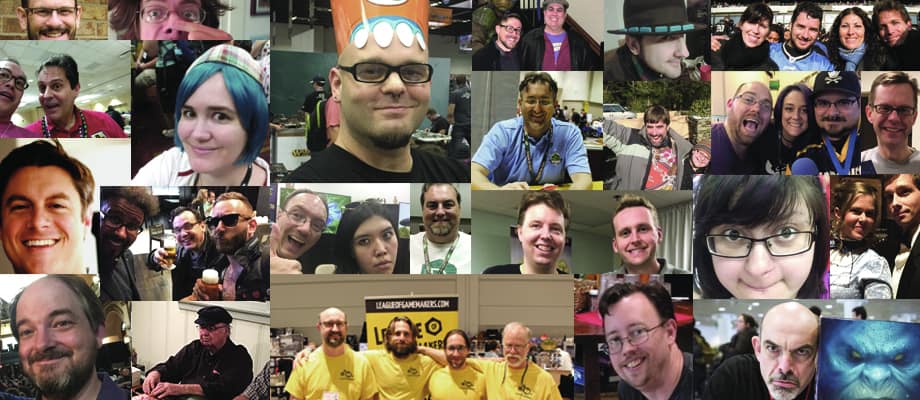
It’s Friday night at the Hammer Downs, Detroit’s legendary high-flying autoduel arena. Two levels, four pairs of launch ramps, and twenty-thousand bloodthirsty fans eager to see us drive too fast and shoot huge guns at each other.
I’m strapped behind the wheel of a tanked-out mid-size worshipping the twin idols of rockets and ramplates. The light turns green. The crowd roars. Me and a sedan both race immediately for the two pairs of ramps here on ground level, looking to score some cheap points in the air; I’m apparently not the only one who emphasized acceleration over firepower.
We each hit a different pair, him a fraction of a second ahead of me. He draws first blood from an expert mid-air burst from his turreted vulcan machine gun. We’re about to criss-cross; his narrow head start when we hit the ramps means we’ll avoid the collision. Barely.
So I say hell with strategy, and trigger my surprise. Two huge blocks of fake armor plating fall off my trunk as the rocket boosters explode to life.
The near-miss becomes a mid-air t-bone. His car literally explodes, the sheer kinetic whallop transforming him into a cloud of confetti. Turns out he was using a lightweight frame to save weight. Whoops.
My joy at the most spectacular kill of my career lasts a fraction of a second.
I hit the arena floor, nowhere near my landing ramp, and the massive debt I’ve been racking-up to physics comes due all at once. The nose of my car bites into the concrete and I vault back into the air. By the time I’m done flipping, rolling, and cursing, the wreckage that used to be my ride comes to a rest against the arena wall. I almost wind-up right-side up and with enough functioning wheels to matter. Almost.
Another car peels off from a run at the ramps and starts hammering me with his machine guns, looking to make sure I’m down for the count. The el cheapo one-shot rocket pod on my roof miraculously survived my acrobatics, so I return fire — and miss.
I’m out of tricks, and I’m not gonna fight on foot — Gold Cross clones don’t come cheap. I stammer out a surrender over the radio. He’s annoyed by my last act of defiance, but accepts the white flag. He’s still got two other actual threats to worry about.
He ultimately wins.
But my highlight leads-off BloodSportCenter that night.
MEMORIES OF A MAD, VANISHED WORLD
When old-timers like me talk about the Good Old Days in tabletop gaming, this is what we’re thinking of.
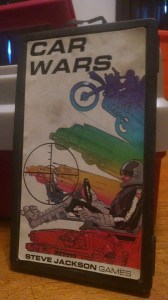
That little box is older than my wife
I got into hobby gaming as a preteen in the early ‘80’s. It was a different world. The elegance, abstraction, and accessibility of the Euros was still over a decade away. With rare exceptions, no matter how ridiculous the subject matter might be, a hobby game devoted to it was going to do its level best to simulate it. And if that meant a whole crapload of fiddly rules, well, so be it.
Even if that game was about a post-apocalyptic world where cars came off the assembly line with enough firepower to challenge a light panzer division.
Car Wars by Steve Jackson Games was (along with FASA’s Battletech) one of the first hobby games I got well and truly into. You and your opponent(s) — who may or may not be your younger brother — have a budget. You make wheeled death machines and shoot it out, either in the arena or the open road.
The base game came in a little black plastic pocket box, but expansions and revised editions were plentiful. (Assuming you could find the bloody things. Seriously, you kids with your internets and amazons; you have no idea.) You played on grid paper with pieces made of light cardstock that you’d cut out yourself — my right thumb and forefinger still ache from remembered scissor-pain as I write this.
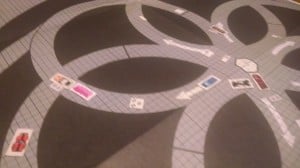
Slugging it out at the New Boston Duelling Arena, aka The Twirling Circles Of Doom
Car Wars captivated me. Part of that was, of course, because The Road Warrior had just come out and was indisputably the greatest movie in the history of humanity. But mostly, it was the construction rules. They were amazing! Okay, first you gotta choose your chassis, and take care the boring stuff, wheels, engine, driver’s seat. And your weapons — your glorious, plentiful weapons, you have so many choices! And your armor. And your chassis needs the space and weight capacity for all that crap. And you have to stay under budget — whoops! You spent twice your budget, didn’t you. Gonna have to sell back some of those guns. And a luxury chassis is overkill, maybe a mid-size would be better….
Embarassingly large swaths of my brain were devoted to the nuances of building tricked-out deathcars for the most adolescent-boy-friendly apocalypse in the history of apocalypses. Judging by the several hundred words I just deleted on the merits of recoilless rifles versus flamethrowers, it seems they still are.
REMOVING THE BLOODROSE-TINTED GLASSES
Now, was Car Wars a “good” game?
No.
Honestly, truly, no. It was not.
The construction rules offered the illusion of infinite variety, but the range of possible good designs was far narrower. Game balance was always an issue and, in the grand tradition of games from all eras, supplements appeared to have been, at best, lightly playtested. SJGames regularly released new catalogs from Uncle Albert’s Auto Stop & Gunnery Shop. They contained lots of useless garbage, several interesting options, and one or two things that flat-out broke the game. (The first generation ramplate basically turned guns into a bulky waste of money. It was eventually nerfed, and even then, my group always treated pure ram cars as poor sportsmanship.)
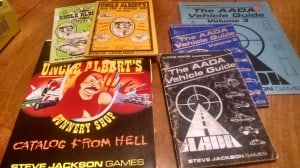
Behold your second-amendment fever dream
You could try limiting players to just the stock cars listed in the American Autodeuling Association Vehicle Guides, but again, your options were vastly more limited than they appeared. The game designers often seemed more interested in worldbuilding than providing options for relatively fair fights, resulting in designs that ranged in quality from “Eh, that’s not bad” to “You’re joking, yes?”
As for the gameplay, for all its pretensions at realism, it was really a crappy simulator. Drivers could make split-second decisions that scoffed at the very concept of “reaction time.” Damage was represented by a simplistic ablative mechanic that got downright silly once collisions entered the fray. The rules as-written included an obscenely important “reflex roll” that gave you a ridiculous advantage if you managed to roll a 5 or 6 on a single die at the very beginning of the game.
A lot of the game was starkly divided against itself. Was it a roleplaying world? A lot of Uncle Al’s gadgets and AADA Vehicle Guides seemed to indicate as much, but the mechanics for the humans behind the wheel seemed decidedly half-baked. And if you were roleplaying, what restrictions did that place on car creation, the heart of the game? Surely you can’t just design a car from the chassis up on a whim, can you?
And as glorious as the highs were, the lows were pretty dire. You might have an epic automotive brawl of such epic awesomeness that Lord Humongous himself would have been proud to epically high-five you … or you might be the poor shmuck who got shattered in mid-air to become part of someone else’s war story. Car Wars involved a hell of a lot of set-up and playtime, with no guarantee of your investment rewarding you with anything resembling “fun.” I remember introducing the game to a friend in college. He spent over an hour looking for his car and tweaking it just right, only to get lit on fire and explode within seconds of rolling on to the arena floor. He never played again. Can you blame him?
To me, that may be the Euros’ greatest contribution to the hobby: a sense of “You will have at least This Much Fun if you sit down for this game.” I’ve seen blowouts in Settlers Of Catan, but I’ve never seen the Robber set somebody’s entire civilization on fire before their second turn.
… NOW LET’S PUT THOSE GLASSES BACK ON
And yet … and yet.
Filter out all the bad stuff from Car Wars, the boring fights and the ill-conceived rules, and I’m left with that time I hollowed-out the only other mobile car in the arena with the final rounds from my twin anti-tank guns before all four of my wheels got ripped off by the spike plate he’d just dropped. Or that time I was furiously flooring it in reverse while my opponent lined-up a ram attack, only for my point-blank desperation shot to destroy his ramplate and turn his coup de grace into a suicide.
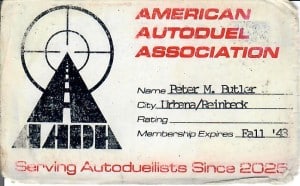
Where did I find this? In my billfold. Where it’s been living. For the past 25 years.
Or the fight from the intro. Because, for real, that really happened. (You know, for tabletop game definitions of “really.”) I really mounted a hidden rocket booster on my car, which was a really silly accessory that was probably only available to pad a supplement’s page count. I really had a ramplate. The timing of that collision was really so specific that it wouldn’t have happened without the rocket assist — and the rules really were so fiddly that yes, increasing my speed by that much at that moment really did cause us to collide. The car I hit really had a lightweight frame that took double damage in collisions — and I really had no idea about it until the other player fessed-up while the dice were being rolled.
And the Confetti Rule. It’s totally A Thing, buried in the Compendium wasting space, only invoked once in all the years I’ve played the game and not affecting the outcome of the game one whit. But I’ll never forget that one time it actually appeared.
So many choices had to have been made just so for that spectacular mid-air beatdown to have happened — and it couldn’t have happened outside of a game as sprawling, self-contradictory, and majestically sloppy as Car Wars.
In the modern game scene, I still see some of what made me love that game so much. Magic: The Gathering owes a lot of its success and longevity to that joy of building your combat engine on your own time and then testing it against an opponent, even if assembling a deck of cards never quite captured my imagination like strapping a flamethrower to a ’57 Chevy. If I ever have the urge to take between-game prep to its logical extreme, Warhammer 40k will gleefully take as much time and money as I choose to give it, and leave me with a beautiful army of miniatures for my trouble.
And I dearly love it when a game has the capacity to surprise me. I get echoes of that old autodueling feel when I’m playing Dominion and somebody spots a card interaction that suddenly transforms the game.
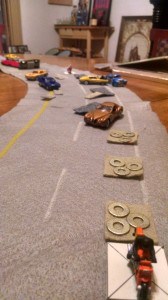
Nothing discourages tailgating like a minedropper
ONCE YOU’VE HAD A TASTE OF VEHICULAR HOMICIDE
But in the meanwhile….
Not only do I still have the game, I doubled-down. About twenty years ago, I made a complete set that, instead of little cardboard cutouts, uses Matchbox cars. I even have two 3-D Matchbox-scale arneas.
Pushing cubes around is nice and all. But sometimes, there’s just no substitute for the arena — in all its messy, unpredictable, this-could-be-a-waste-of-your-time-but-OMFG-what-if-it’s-not glory.
Drive offensively.

